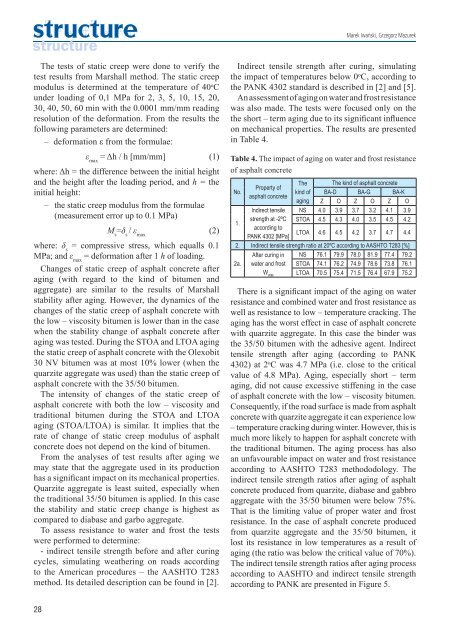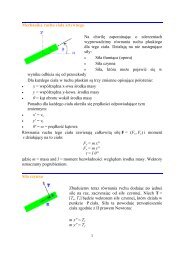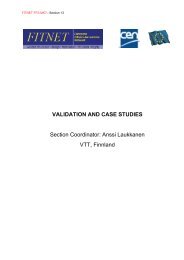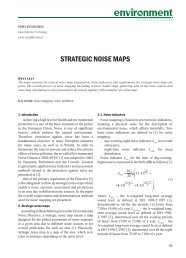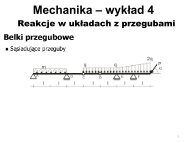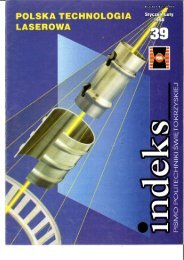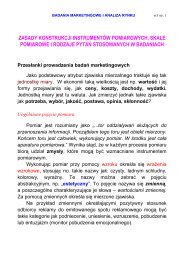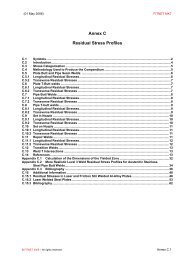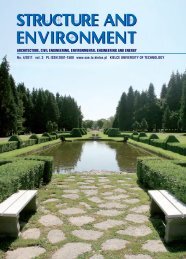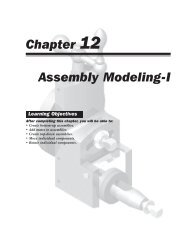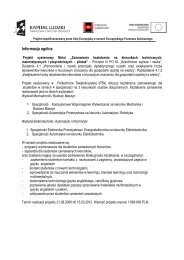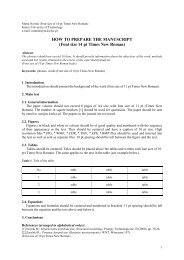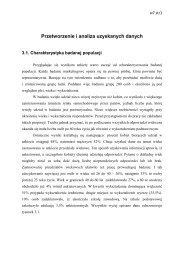Pobierz pełny numer 1/2010 S&E - Structure and Environment - Kielce
Pobierz pełny numer 1/2010 S&E - Structure and Environment - Kielce
Pobierz pełny numer 1/2010 S&E - Structure and Environment - Kielce
- No tags were found...
You also want an ePaper? Increase the reach of your titles
YUMPU automatically turns print PDFs into web optimized ePapers that Google loves.
Marek Iwański, Grzegorz MazurekThe tests of static creep were done to verify thetest results from Marshall method. The static creepmodulus is determined at the temperature of 40 o Cunder loading of 0,1 MPa for 2, 3, 5, 10, 15, 20,30, 40, 50, 60 min with the 0.0001 mm/mm readingresolution of the deformation. From the results thefollowing parameters are determined:– deformation ε from the formulae:ε max= Δh / h [mm/mm] (1)where: Δh = the difference between the initial height<strong>and</strong> the height after the loading period, <strong>and</strong> h = theinitial height:– the static creep modulus from the formulae(measurement error up to 0.1 MPa)M s=δ s/ ε max(2)where: δ s= compressive stress, which equalls 0.1MPa; <strong>and</strong> ε max= deformation after 1 h of loading.Changes of static creep of asphalt concrete afteraging (with regard to the kind of bitumen <strong>and</strong>aggregate) are similar to the results of Marshallstability after aging. However, the dynamics of thechanges of the static creep of asphalt concrete withthe low – viscosity bitumen is lower than in the casewhen the stability change of asphalt concrete afteraging was tested. During the STOA <strong>and</strong> LTOA agingthe static creep of asphalt concrete with the Olexobit30 NV bitumen was at most 10% lower (when thequarzite aggregate was used) than the static creep ofasphalt concrete with the 35/50 bitumen.The intensity of changes of the static creep ofasphalt concrete with both the low – viscosity <strong>and</strong>traditional bitumen during the STOA <strong>and</strong> LTOAaging (STOA/LTOA) is similar. It implies that therate of change of static creep modulus of asphaltconcrete does not depend on the kind of bitumen.From the analyses of test results after aging wemay state that the aggregate used in its productionhas a significant impact on its mechanical properties.Quarzite aggregate is least suited, especially whenthe traditional 35/50 bitumen is applied. In this casethe stability <strong>and</strong> static creep change is highest ascompared to diabase <strong>and</strong> garbo aggregate.To assess resistance to water <strong>and</strong> frost the testswere performed to determine:- indirect tensile strength before <strong>and</strong> after curingcycles, simulating weathering on roads accordingto the American procedures – the AASHTO T283method. Its detailed description can be found in [2].Indirect tensile strength after curing, simulatingthe impact of temperatures below 0 o C, according tothe PANK 4302 st<strong>and</strong>ard is described in [2] <strong>and</strong> [5].An assessment of aging on water <strong>and</strong> frost resistancewas also made. The tests were focused only on thethe short – term aging due to its significant influenceon mechanical properties. The results are presentedin Table 4.Table 4. The impact of aging on water <strong>and</strong> frost resistanceof asphalt concreteNo.1.Property ofasphalt concreteIndirect tensilestrength at -2ºCaccording toPANK 4302 [MPa]Thekind ofagingThe kind of asphalt concreteBA-D BA-G BA-KZ O Z O Z ONS 4.0 3.9 3.7 3.2 4.1 3.9STOA 4.5 4.3 4.0 3.5 4.5 4.2LTOA 4.6 4.5 4.2 3.7 4.7 4.42. Indirect tensile strength ratio at 20ºC according to AASHTO T283 [%]After curing in NS 76.1 79.9 78.0 81.9 77.4 79.2W WMLTOA 70.5 75.4 71.5 76.4 67.9 75.22a. water <strong>and</strong> frost STOA 74.1 76.2 74.9 78.6 73.8 76.1There is a significant impact of the aging on waterresistance <strong>and</strong> combined water <strong>and</strong> frost resistance aswell as resistance to low – temperature cracking. Theaging has the worst effect in case of asphalt concretewith quarzite aggregate. In this case the binder wasthe 35/50 bitumen with the adhesive agent. Indirecttensile strength after aging (according to PANK4302) at 2 o C was 4.7 MPa (i.e. close to the criticalvalue of 4.8 MPa). Aging, especially short – termaging, did not cause excessive stiffening in the caseof asphalt concrete with the low – viscosity bitumen.Consequently, if the road surface is made from asphaltconcrete with quarzite aggregate it can experience low– temperature cracking during winter. However, this ismuch more likely to happen for asphalt concrete withthe traditional bitumen. The aging process has alsoan unfavourable impact on water <strong>and</strong> frost resistanceaccording to AASHTO T283 methododology. Theindirect tensile strength ratios after aging of asphaltconcrete produced from quarzite, diabase <strong>and</strong> gabbroaggregate with the 35/50 bitumen were below 75%.That is the limiting value of proper water <strong>and</strong> frostresistance. In the case of asphalt concrete producedfrom quarzite aggregate <strong>and</strong> the 35/50 bitumen, itlost its resistance in low temperatures as a result ofaging (the ratio was below the critical value of 70%).The indirect tensile strength ratios after aging processaccording to AASHTO <strong>and</strong> indirect tensile strengthaccording to PANK are presented in Figure 5.28


